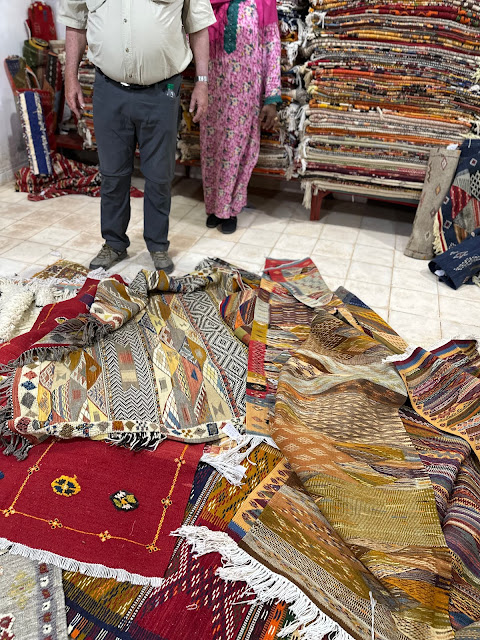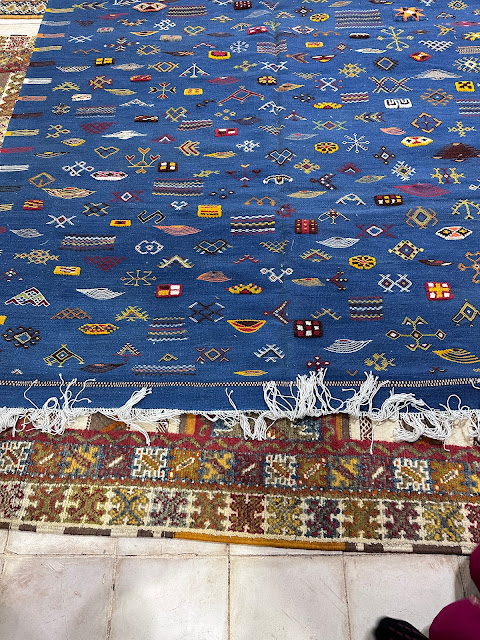As part of a recent trip, i visited a women’s rug co op in the south of Morocco. It’s located in a village called Ait Ben Haddou, a UNESCO World Heritage site located on the southern edge of the High Atlas Mountains. It has also been used as the location for several movie productions (Gladiator, and Game of Thrones-season 3).
The villagers are Amazigh (aka Berber), and have a strong tradition of colourful textiles with intricate details. The lady below was wearing a black dress with lace/embroidery detail, and had hennaed fingers.
The Coooperative is called Aknif Lglaoui, run by local women looking to generate income and educational opportunities. There are about 60 women involved, mostly working from home, with a few folks staffing their show room in town.
These ladies do it all from start to finish….they collect the fleeces, wash them, card the wool, spin it and dye it….then they get to work on the weaving The looms we saw were constructed with vertical i-beams and cross bars of wood (approx 2x6 size).
Their show room is packed to the ceiling with all manner of rugs for sale, and they willingly pull them out for potential buyers to peruse.
Price-wise, they were fairly reasonable - we estimated most prices to be in the $30-$70 cdn per square foot. Waaaay cheaper than would typically be charged for a comparable size hooked rug in Canada - there is at least the same, if not a ton more, effort put into these rugs as a hooked rug.
An interesting tidbit on care of these rugs: in winter, the rugs are used “good” side up. In summer they are flipped over and used good side down. This allows for any embedded dirt to be extracted during daily use. There is snow in the Atlas Mountains not too far from Ait Ben Haddou, but i doubt they use it to clean rugs there.
The rugs fall into 3 distinct categories, based on the materials to construct them:
- woolen rugs
- agave silk rugs
- boucherouite rugs
All of the rugs use a cotton warp as a foundation.
Woolen rugs
These use the wool that was carded, spun and dyed by cooperative members. Dyes are largely natural: indigo for blue, pomegranate rinds for yellow, etc. There were several instances where coloured fleeces were used in their natural state.
 |
| Left: natural gray fleece; Right: natural brown fleece. |
Some rugs have symbols woven into them, some have symbols embroidered, and some have them knotted. Embroidery and knotting is usually done as the rug is woven, not added afterward. Some rugs are completely done via knotting, and have a shaggier appearance. The ends on the embroidered rugs are not woven in or knotted - they’re simply left loose on the reverse side. I suspect that these will felt into the main body of the rug over time.
Here is an example of all 3 methods: the upper symbol is embroidered, the middle symbol is knotted (and trimmed) and the lower symbol is woven.
Here is an entire rug done via latch-hook method - ie the rug is woven, and then tufts of yarn are knotted into the woven base.
Another style of woolen rug looks more like a patchwork design, but is created line by line. The colours in these are fairly balanced so the weaver must keep track of what they are doing as they go along. A 5x8 rug can take 8 months to complete - worked on as time permits.I don’t have any examples of these rugs taken at the cooperative, but here are some from other shops, to give you an idea of the patterns.
I didn’t ask, but i suspect these rugs represent ways of using up your stash.Agave Silk Rugs
Rugs made with agave have a very different feel to wool rugs, and seem almost like an outdoor rug. The designs on these rugs are often embroidered on.
One of the ladies on our tour bought a long runner, but arranged for the cooperative folks to cut it into 2 pieces, and refringe the ends.
Boucherouite Rugs
These are rugs that are made from old clothing (sound familiar?). The patterns used for them are not as precise as for the woolen rugs. Sometimes they are woven into a simple rag rug. Other times they are knotted into more of a Proddy style. Sometimes you see them made with yarn.
I had to ask to see some, and was taken into another room, but later i realized that we were all sitting on them during the presentation.
Most of the fabrics used in these are synthetic - both woven and knit. When i asked about the materials for boucherouites all of the ladies tugged at their sleeves to indicate that they used old clothing.
Here are some more boucherouites seen in the souks of Marrakech.
….and yes, i bought a woven one (not a boucherouite) at the cooperative. Natural gray wool, with embroidered, knotted and woven Amazigh symbols.





































No comments:
Post a Comment